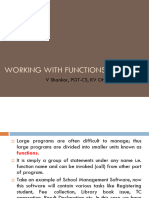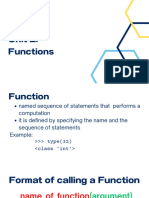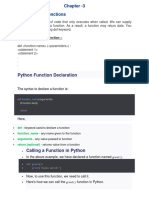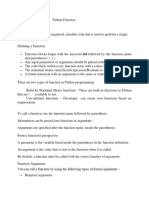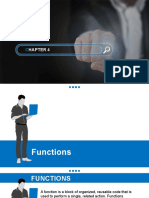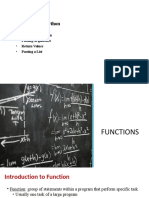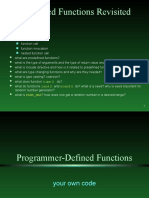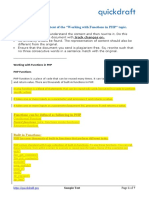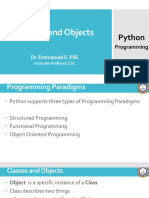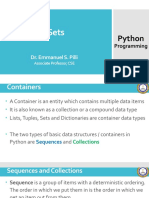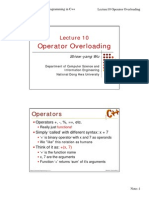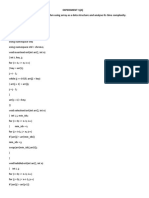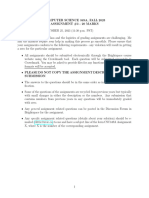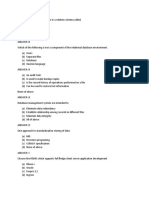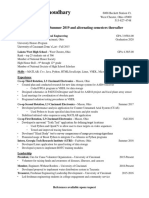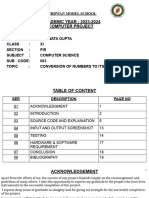0 ratings0% found this document useful (0 votes)
15 viewsPython 10
Python 10
Uploaded by
HemangFunctions in Python allow programmers to divide programs into modular tasks. There are built-in functions included with Python and user-defined functions created by programmers. Functions can be called multiple times and parameters allow communication between functions and the calling code. Functions help debug programs by isolating logical errors and reusable functions improve efficiency.
Copyright:
© All Rights Reserved
Available Formats
Download as PDF, TXT or read online from Scribd
Python 10
Python 10
Uploaded by
Hemang0 ratings0% found this document useful (0 votes)
15 views8 pagesFunctions in Python allow programmers to divide programs into modular tasks. There are built-in functions included with Python and user-defined functions created by programmers. Functions can be called multiple times and parameters allow communication between functions and the calling code. Functions help debug programs by isolating logical errors and reusable functions improve efficiency.
Copyright
© © All Rights Reserved
Available Formats
PDF, TXT or read online from Scribd
Share this document
Did you find this document useful?
Is this content inappropriate?
Functions in Python allow programmers to divide programs into modular tasks. There are built-in functions included with Python and user-defined functions created by programmers. Functions can be called multiple times and parameters allow communication between functions and the calling code. Functions help debug programs by isolating logical errors and reusable functions improve efficiency.
Copyright:
© All Rights Reserved
Available Formats
Download as PDF, TXT or read online from Scribd
Download as pdf or txt
0 ratings0% found this document useful (0 votes)
15 views8 pagesPython 10
Python 10
Uploaded by
HemangFunctions in Python allow programmers to divide programs into modular tasks. There are built-in functions included with Python and user-defined functions created by programmers. Functions can be called multiple times and parameters allow communication between functions and the calling code. Functions help debug programs by isolating logical errors and reusable functions improve efficiency.
Copyright:
© All Rights Reserved
Available Formats
Download as PDF, TXT or read online from Scribd
Download as pdf or txt
You are on page 1of 8
Functions
Python
Programming
Dr. Emmanuel S. Pilli
Associate Professor, CSE
Functions
A block of code that performs a specific and well defined task
Functions help divide the program into multiple tasks.
A big task can be defined as many smaller functions making the
programme modular
Functions provide reuse mechanism and the same function can
be called any number of times
Functions help in debugging and identifying the location of the
faults / logical errors easily
Types of Functions
Built-in Functions – functions are predefined and are included as
part of the python compiler
User define functions – programmer can create functions and
use them in programmes
Format of a User defined function fun( )
def fun ( ):
statements
statements
Function Rules
Function can be called any number of times
When a function is called, the control is transferred to the
function . The statements in the function are executed and
control is returned to place from where it originated
Use lower case and underscore (_) is used to connect words
Function can be redefined. Latest definition will be called.
Function definitions can be nested. The inner function is able
to access the variables of the outer function. The outer
function has to be called for inner function to be executed.
Communication with Functions (Arguments)
Communication with functions can be done using parameters
or arguments passed to it and the value(s) returned from it.
The way to pass values to a function and return value from
the function:
def fun (p1, p2, p3):
statements
return(r)
Return statement returns control and value from a function.
Return without an expression returns None
Communication with Functions (Arguments)
To return multiple values from a function, store them in a list,
tuple, set or dictionary and return them
If we pass arguments a, b, c to a function and collect them in
x, y, z then changing x, y, z values will not change a, b, c
Function is always called by value
A function can return different values through different return
statements
The function which reaches the end of the execution without
a return statement will always return None
Types of Arguments
Four types of Arguments
Positional arguments
Keyword arguments
Variable length positional arguments
Variable length keyword arguments
Positional and Keyword arguments are called required
arguments and variable length arguments are called
optional
Types of Arguments
Positional arguments must be passed in correct positional order
Type of arguments and Number of arguments passed must
match with the type and number received
Keyword arguments can be passed out of order
Python interpreter uses keywords (variable names) to match
the values passed with the arguments used in the function
definition
A function call can have positional and keyword arguments, but
the positional arguments must precede keyword arguments
You might also like
- Maya Python A PiDocument582 pagesMaya Python A Pirendermanuser100% (1)
- On The Fly Reset in UVMDocument7 pagesOn The Fly Reset in UVMChandan ChoudhuryNo ratings yet
- PPS Unit 3Document50 pagesPPS Unit 3vanisays.havesomepaaniNo ratings yet
- Python Unit IIIDocument8 pagesPython Unit IIIennoreboopathichitraNo ratings yet
- 2_Functions1Document77 pages2_Functions1itssohail099No ratings yet
- Working With FunctionsDocument72 pagesWorking With Functionssurinderkumar8793No ratings yet
- Unit 2Document46 pagesUnit 2AshteriteNo ratings yet
- Function InroductionDocument29 pagesFunction Inroductioniitiansrd2025No ratings yet
- Chapter-3 Working With FunctionsDocument6 pagesChapter-3 Working With FunctionsaaNo ratings yet
- 06 - Chapter 05_2Document35 pages06 - Chapter 05_2zhelunofficalNo ratings yet
- Module 4 - Functions Modules and PackagesDocument12 pagesModule 4 - Functions Modules and PackagesavishkarNo ratings yet
- Chapter-3 Functions in PythonDocument6 pagesChapter-3 Functions in PythonHemant NtlNo ratings yet
- Chapter-2 FunctionDocument40 pagesChapter-2 FunctionAshwin Shukla100% (1)
- Functions In PythonDocument7 pagesFunctions In PythonArvind rockNo ratings yet
- Python Day 4 FunctionDocument5 pagesPython Day 4 FunctionPriyaGandhiNo ratings yet
- How To Use FunctionsDocument12 pagesHow To Use Functionsbodi16No ratings yet
- Working With Functions-2 2022-23Document55 pagesWorking With Functions-2 2022-23sharanshajiixc36No ratings yet
- FunctionsDocument6 pagesFunctionsChandrika SuryaNo ratings yet
- Unit7 FunctionsDocument13 pagesUnit7 Functionsjpokhrl22No ratings yet
- CH 3 FunctionsDocument2 pagesCH 3 FunctionsUma TNANo ratings yet
- PYTHONDocument53 pagesPYTHONWalterNo ratings yet
- Reading Assignment: K.N. King Sections 7.1, 7.2, 7.5 Sections 16.5, 18.2, 20.1Document23 pagesReading Assignment: K.N. King Sections 7.1, 7.2, 7.5 Sections 16.5, 18.2, 20.1SateeshReddyNo ratings yet
- C++ Function: Chapter-5Document36 pagesC++ Function: Chapter-5Biya KumilachewNo ratings yet
- Module 2Document27 pagesModule 2shahany habeebNo ratings yet
- End Sem Question Bank and SolutionDocument19 pagesEnd Sem Question Bank and Solutiona55854494No ratings yet
- Chapter 4 FunctionsDocument24 pagesChapter 4 FunctionsanimehorahoraNo ratings yet
- Chapter 6 Function - CombinedDocument44 pagesChapter 6 Function - Combinedrabbiatul adawiyahNo ratings yet
- Int. Prog ReviewerDocument2 pagesInt. Prog ReviewerMark Samuel Dela cruzNo ratings yet
- UntitledDocument35 pagesUntitledgowrisankar_kalakotiNo ratings yet
- Functions Notes 1Document24 pagesFunctions Notes 1SANTOSH KEKANENo ratings yet
- Working With: Chapter - 3Document22 pagesWorking With: Chapter - 3Harsh RawatNo ratings yet
- Function in PythonDocument13 pagesFunction in PythonRahul DasNo ratings yet
- PPL Unit 4Document67 pagesPPL Unit 4ausera1991aNo ratings yet
- Unit 3 PHPDocument15 pagesUnit 3 PHPChandana GoudaNo ratings yet
- Functions in CDocument18 pagesFunctions in CSainiNishrithNo ratings yet
- Python Unit-4Document17 pagesPython Unit-4DenuNo ratings yet
- Working With Functions-2Document78 pagesWorking With Functions-2geetarai85639No ratings yet
- 'Python Notes Unit 2Document18 pages'Python Notes Unit 2Veeranan SenniahNo ratings yet
- Array: Passing Arrays As Function Arguments in CDocument10 pagesArray: Passing Arrays As Function Arguments in CVikas KunduNo ratings yet
- Chapter 3 - Working With FunctionsDocument6 pagesChapter 3 - Working With FunctionsADITIYANo ratings yet
- Lesson 4 - FunctionsDocument25 pagesLesson 4 - FunctionsDeleon, John Kevin L.No ratings yet
- Function in PythonDocument12 pagesFunction in PythonArshdeep SinghNo ratings yet
- Programming Fundamentals: Practical#07)Document29 pagesProgramming Fundamentals: Practical#07)Tooba AkhtarNo ratings yet
- Unit-7 (Functions) PDFDocument13 pagesUnit-7 (Functions) PDFSrijit koirlaNo ratings yet
- Lecture 7 - FunctionsDocument21 pagesLecture 7 - Functionswsa asddNo ratings yet
- Lesson5 - PythonDocument5 pagesLesson5 - Pythonmoamenadel199No ratings yet
- User Defined FunctionsDocument31 pagesUser Defined FunctionsReddappaNo ratings yet
- FunctionsDocument16 pagesFunctionsHarsh BajajNo ratings yet
- Lecture 13 FunctionsDocument73 pagesLecture 13 FunctionsArsalan AhmedNo ratings yet
- C-Notes Module 3Document5 pagesC-Notes Module 3jagatamil2016No ratings yet
- Introduction To FunctionDocument22 pagesIntroduction To Functionaamirneyazi12No ratings yet
- Functions: Department of Mechanical EngineeringDocument22 pagesFunctions: Department of Mechanical EngineeringSubbu SuniNo ratings yet
- Predefined Functions Revisited: Time Rand Srand Rand - MaxDocument13 pagesPredefined Functions Revisited: Time Rand Srand Rand - MaxMUHAMMAD HASEEB ASHRAF MUHAMMAD ASHRAFNo ratings yet
- VHDL PDFDocument250 pagesVHDL PDFSai GautamNo ratings yet
- 03MAYDocument7 pages03MAYdollar contentNo ratings yet
- C - FunctionDocument28 pagesC - FunctionSadman WasifNo ratings yet
- Session 18Document16 pagesSession 18Gagan ShuklaNo ratings yet
- Types of SubprogramsDocument255 pagesTypes of SubprogramsVishwanath PattarNo ratings yet
- Python Advanced Programming: The Guide to Learn Python Programming. Reference with Exercises and Samples About Dynamical Programming, Multithreading, Multiprocessing, Debugging, Testing and MoreFrom EverandPython Advanced Programming: The Guide to Learn Python Programming. Reference with Exercises and Samples About Dynamical Programming, Multithreading, Multiprocessing, Debugging, Testing and MoreNo ratings yet
- CamScanner 03-31-2023 17.55.15Document14 pagesCamScanner 03-31-2023 17.55.15HemangNo ratings yet
- Python 12Document11 pagesPython 12HemangNo ratings yet
- Python 7Document11 pagesPython 7HemangNo ratings yet
- Python 6Document12 pagesPython 6HemangNo ratings yet
- Python 8Document13 pagesPython 8HemangNo ratings yet
- Python 9Document11 pagesPython 9HemangNo ratings yet
- Python 2Document28 pagesPython 2HemangNo ratings yet
- Python 4Document13 pagesPython 4HemangNo ratings yet
- Python 5Document25 pagesPython 5HemangNo ratings yet
- Python 3Document17 pagesPython 3HemangNo ratings yet
- Python 1Document15 pagesPython 1HemangNo ratings yet
- Programming Fundamentals Chapter 1 INTRODocument31 pagesProgramming Fundamentals Chapter 1 INTROMichael T. BelloNo ratings yet
- Oop Operator OverloadDocument44 pagesOop Operator OverloadYousaf RiazNo ratings yet
- C# Lab ManualDocument20 pagesC# Lab Manualpankhi_20077474100% (3)
- Trapizoidal MethodDocument5 pagesTrapizoidal MethodLn Amitav BiswasNo ratings yet
- Channel Coding For Modern Communication Systems: Presented by Yasir Mehmood (200411018)Document20 pagesChannel Coding For Modern Communication Systems: Presented by Yasir Mehmood (200411018)MaryamNo ratings yet
- Python Data StructureDocument73 pagesPython Data StructureUDAY SLATHIA (RA2111003011085)100% (1)
- LSA Data Excellence-Handout PDFDocument25 pagesLSA Data Excellence-Handout PDFPriyanshu YadavNo ratings yet
- 01a - Introduction - CSC 343Document8 pages01a - Introduction - CSC 343Partha KuriNo ratings yet
- Java Question BPUTDocument8 pagesJava Question BPUTSYAMANTA GARUDNo ratings yet
- Elevatorsetup: Class PublicDocument5 pagesElevatorsetup: Class PublicRakhmeen GulNo ratings yet
- CS201 All Finalterm Papers Mega FileDocument90 pagesCS201 All Finalterm Papers Mega FileMian Ejaz0% (1)
- Improve Communication Between Your C - C++ Applications and SAP Systems With SAP NetWeaver RFC SDK - Part 3: Advanced TopicsDocument18 pagesImprove Communication Between Your C - C++ Applications and SAP Systems With SAP NetWeaver RFC SDK - Part 3: Advanced Topicsdeejay217No ratings yet
- Module 6Document15 pagesModule 6Mihai SNo ratings yet
- Ada FileDocument17 pagesAda FilevishalNo ratings yet
- Creating RAIN EFFECT With ACTIONSCRIPTDocument9 pagesCreating RAIN EFFECT With ACTIONSCRIPTRuby BartNo ratings yet
- Out System Interview PointsDocument15 pagesOut System Interview PointsKARTHIK NNo ratings yet
- Csc349a f2023 Asn3Document4 pagesCsc349a f2023 Asn3mileskticknerNo ratings yet
- Lecture 2 - MIPS Architecture Part I - Instruction SetDocument53 pagesLecture 2 - MIPS Architecture Part I - Instruction SetLaurenceNo ratings yet
- ModuleDocument79 pagesModuleAditya ChowdaryNo ratings yet
- Adeel Full StackDocument3 pagesAdeel Full StackRAJ RAJANNo ratings yet
- Ansh Bhawnani: Python Beginner's Course Bitten TechDocument26 pagesAnsh Bhawnani: Python Beginner's Course Bitten TechDalllas reviews100% (1)
- FOSS Lab Programs ListDocument3 pagesFOSS Lab Programs ListLokesh Sai Kumar DasariNo ratings yet
- CLanguageSeries1 PDFDocument223 pagesCLanguageSeries1 PDFCopernicus PepitoNo ratings yet
- 300 Database MCQsDocument58 pages300 Database MCQsFAISAL ABBAS100% (1)
- Rishabh Choudhary ResumeDocument1 pageRishabh Choudhary Resumeapi-432541613No ratings yet
- Bachelor of Computer Science (Hons) (With Specialization)Document3 pagesBachelor of Computer Science (Hons) (With Specialization)JakeBondNo ratings yet
- Full Stack Development Bootcamp: 11 Months - OnlineDocument12 pagesFull Stack Development Bootcamp: 11 Months - OnlinesyedahmedjNo ratings yet
- Computer ProjectDocument21 pagesComputer ProjectsnehasishchakraboiNo ratings yet




